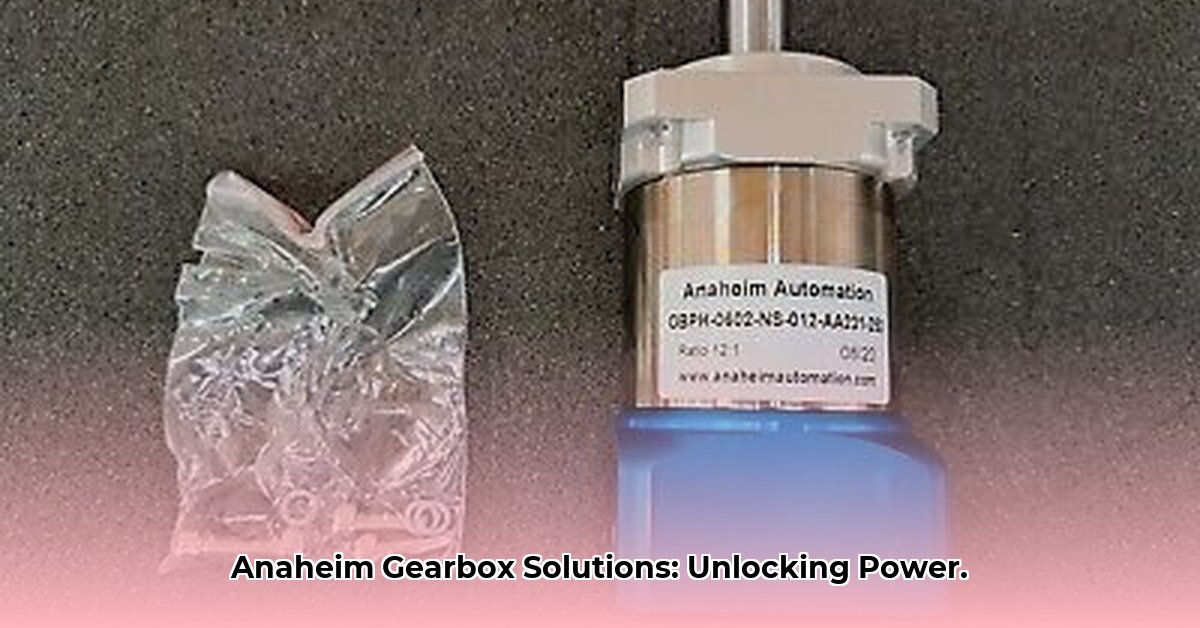
The Ever-Evolving Landscape of Gearbox Technology
The market for high-performance gear components is dynamic, spanning legacy automotive applications and the burgeoning demands of industrial automation. Sourcing parts for classic vehicles presents unique challenges, often requiring extensive searches and potentially high costs. Conversely, the industrial sector fuels significant demand for robust, adaptable gearboxes capable of handling heavy loads, diverse motor types, and demanding operating conditions. Anaheim Gear and Anaheim Automation are key players navigating these contrasting landscapes. How are they meeting these diverse needs?
Anaheim Gear: Enhancing Automotive Performance
Anaheim Gear focuses on enhancing automotive performance through high-quality upgrades. While precise sales figures remain undisclosed, their online presence indicates robust interest from both enthusiasts and professional tuners. Their offerings focus on improving vehicle acceleration, shifting smoothness, and overall drivetrain robustness. Crucially, their success hinges on effectively managing supply chains, particularly for hard-to-find components. This requires adept sourcing of materials and strategic inventory management. Is their supply chain resilience sufficient to meet the demands of a rapidly changing market?
Anaheim Automation: Powering Industrial Applications
Anaheim Automation caters to the industrial sector, providing heavy-duty gearboxes engineered for demanding applications. Their gearboxes boast impressive torque capacities (up to 10,488 inch-pounds), high gear ratios (up to 30:1), and compatibility with various motor types (servos, steppers, brushless DC, and AC motors). This versatility enables diverse applications across numerous industries. Their competitive advantage likely stems from a combination of efficiency, customization capabilities, and a strong reputation for reliability. What are the key factors driving their success in this competitive market?
Actionable Insights for Key Stakeholders
Let's examine strategic recommendations for various stakeholders:
| Stakeholder Group | Short-Term Strategies | Long-Term Strategies |
|---|---|---|
| Anaheim Gear & Competitors | Secure robust supply chains, explore strategic partnerships, offer remanufacturing services. | Develop innovative products, expand into new markets (e.g., e-commerce), invest in targeted marketing campaigns. |
| Anaheim Automation & Competitors | Enhance online resources, improve customer service, showcase successful case studies. | Focus on R&D for even higher torque capacities and broader motor compatibility, explore sustainable manufacturing. |
| Automotive Enthusiasts | Identify reliable suppliers, anticipate potential delays, compare features and pricing. | Stay informed about new performance upgrades, carefully weigh cost, performance, and durability trade-offs. |
| Industrial Automation Customers | Define precise specifications, verify motor compatibility, compare vendor offerings. | Analyze total cost of ownership (TCO), prioritize energy efficiency, ensure robust solutions. |
Risk Mitigation and Regulatory Compliance
Proactive risk management is critical for success. Key risks and mitigation strategies include:
| Technology/Component | Risk Category | Likelihood | Impact | Mitigation Strategies |
|---|---|---|---|---|
| High-Performance Upgrades | Supply Chain Disruptions | Medium | High | Diversify suppliers, cultivate strong supplier relationships, explore alternative sourcing. |
| Older Automotive Parts | Part Obsolescence | High | High | Focus on remanufacturing, develop compatible alternatives, utilize 3D printing. |
| Industrial Gearboxes | Manufacturing Defects | Low | Medium | Implement rigorous quality control, invest in exhaustive testing and validation. |
| Online Sales | Cybersecurity Threats | Low | High | Invest in robust cybersecurity measures, adhere to industry best practices. |
Adherence to relevant safety and environmental regulations (ISO, ANSI, etc.) is paramount. Maintaining compliance and protecting intellectual property are also essential for long-term success.
Conclusion: Navigating the Future of Gearbox Technology
Anaheim Gear and Anaheim Automation occupy crucial positions within their respective markets. Their ability to adapt to evolving demands and mitigate potential risks will determine their future success. Further research into materials science and manufacturing advancements will be crucial in shaping the future of gearbox technology. The effective management of supply chains and a keen focus on customer needs will be instrumental in navigating this dynamic landscape.